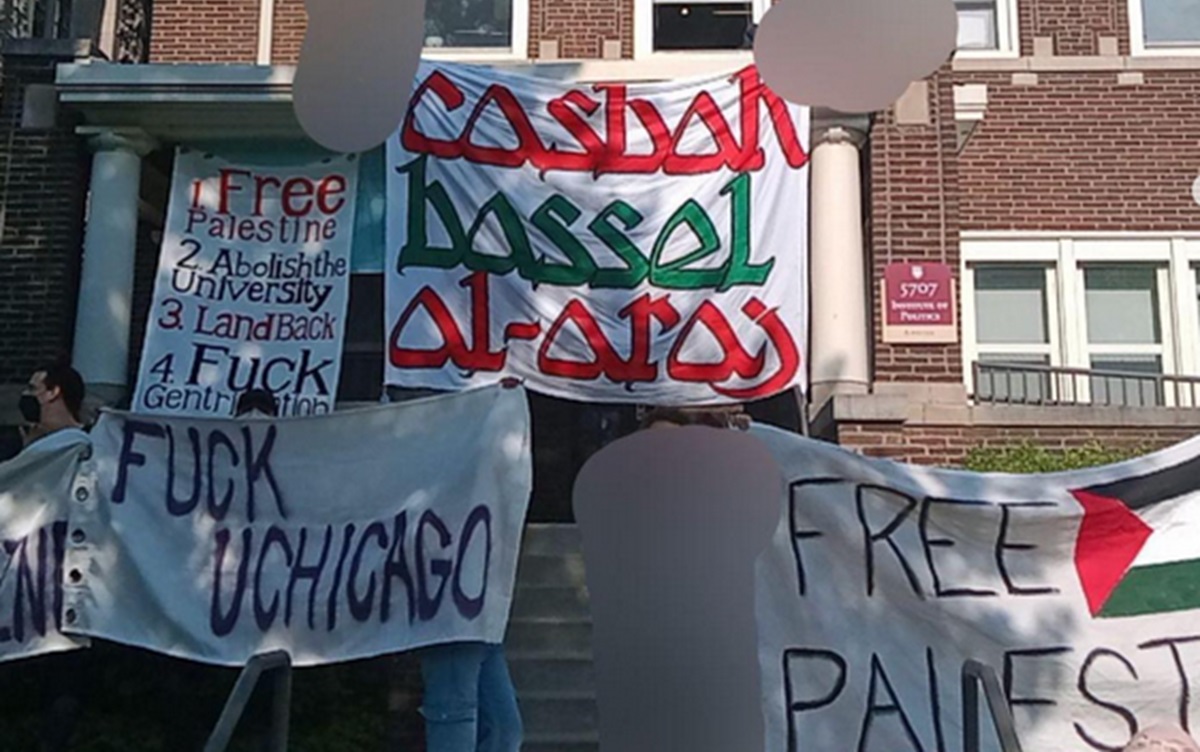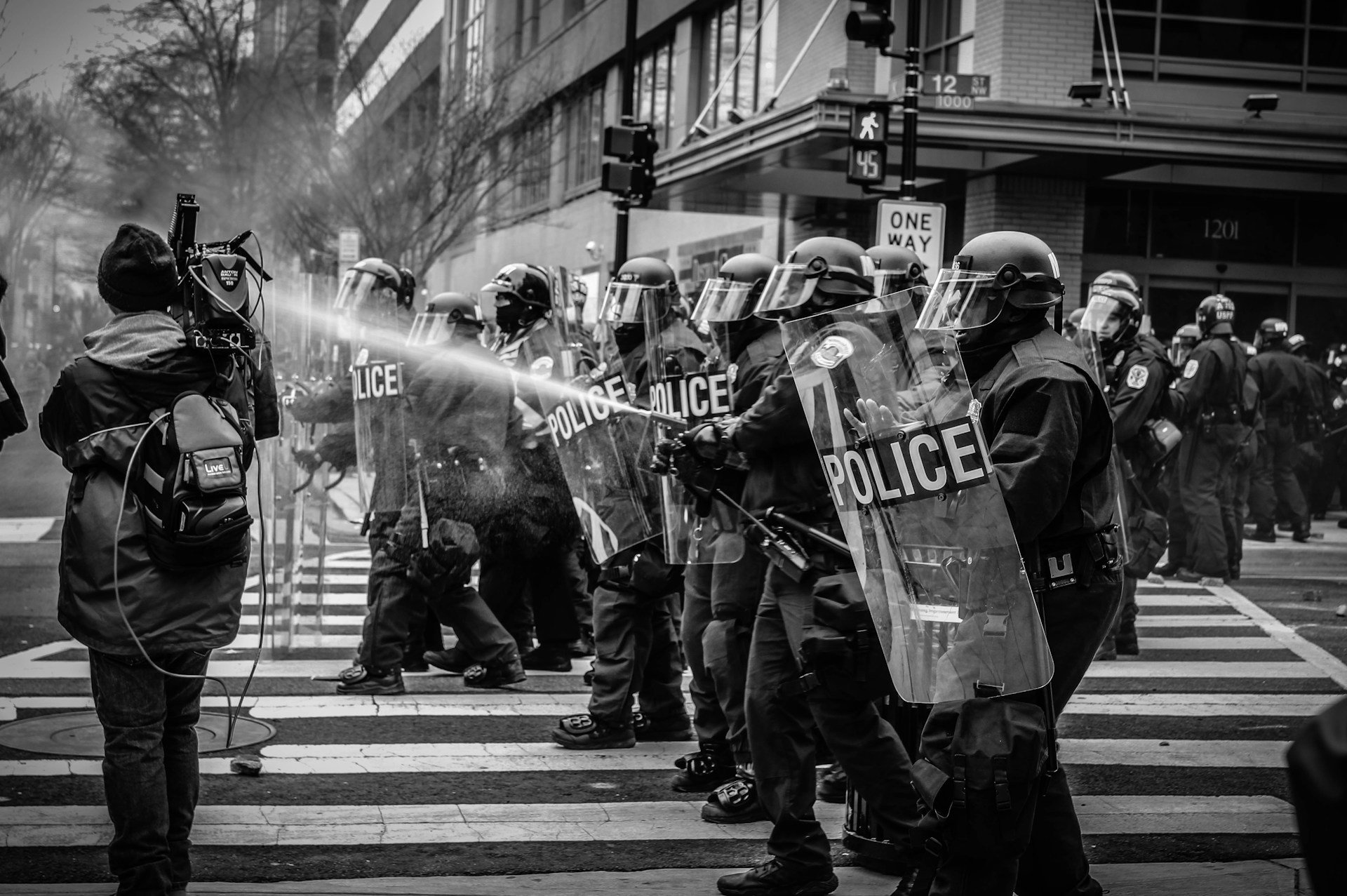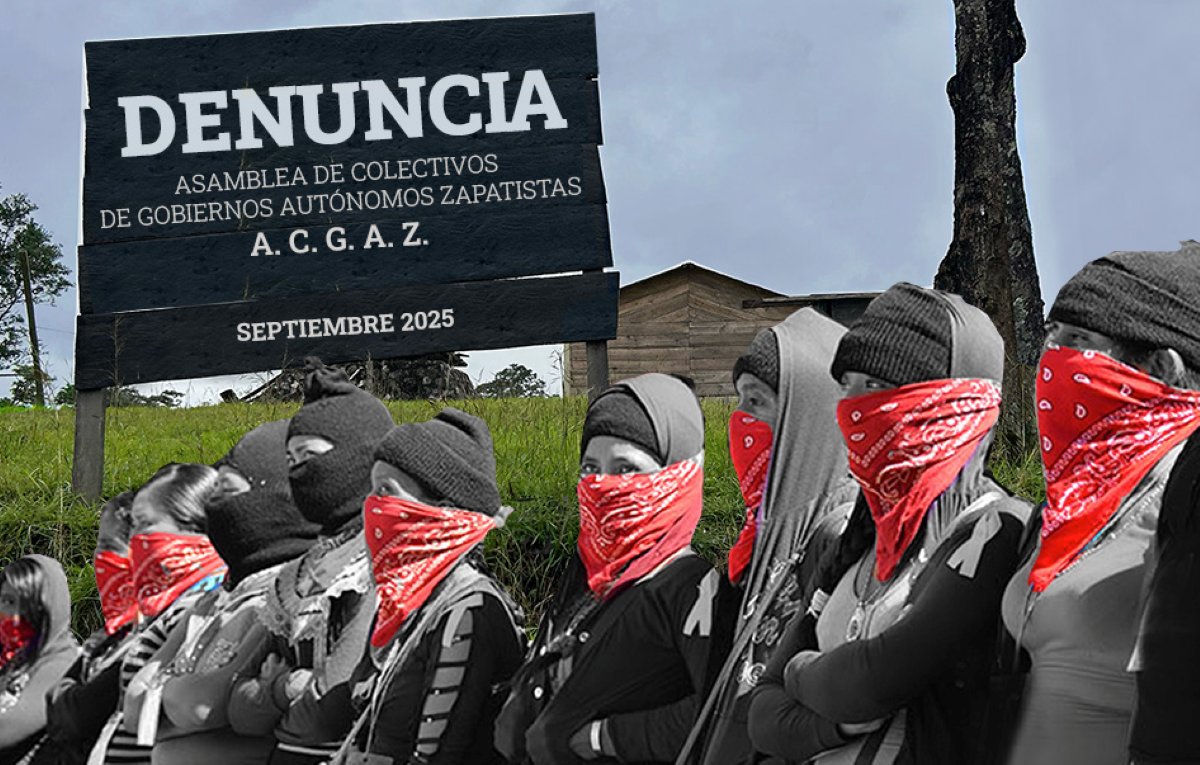Filed under: Action, Analysis, Midwest, Solidarity, War

Report and analysis on recent occupation at the University of Chicago in solidarity with the people of Palestine.
“The flea has fascinating fighting strategies and techniques…It does not kill its host…what it does is exhaust its host and consume its blood, causing constant disturbance, eventually preventing the host from being able to rest. It makes the host nervous and demoralized. […]
[T]he guerilla fights its wars like fleas…If the battle lasts long enough to exhaust the host then it will fail in the battle due to its weakness while unable to locate the flea(s)…[F]ight like a flea.” – Live Like A Porcupine, Fight Like A Flea
“The beginning of every revolution is an exit, an exit from the social order that power has enshrined in the name of law, stability, public interest, and the greater good.” – Exiting Law & Entering Revolution
Since October 7th, Chicago has seen countless marches and actions that have been successful in bringing out hundreds and thousands of people. However, many of these numbers consist of suburbanites driving or being bussed into the city to show support, rather than a mass of Chicagoans coming together from across the deeply race- and class-segregated city. In addition, these marches have usually been put on by a small number of nonprofit organizations. They have been heavily marshaled and largely symbolic, leaving many people demoralized and looking for more.
As every day sees more Gazans murdered by the zionist entity, symbolic parades that play into respectability politics at every turn and ask the state for permission to protest are clearly a toothless and insufficient response. Small, isolated acts of sabotage aren’t enough either—it is crucial to seek more militant forms of collective action. These actions should demonstrate an understanding of the throughline between the colonial states of the US and Israel, and the need to abolish both entirely—prisons, police, military, and state bureaucracies alike—to stop both the genocide in Gaza and the daily forms of state violence here in Chicago. From within the imperial core, there’s an obligation to interrupt the material support that the “U.S.” provides “israel.”
In order to encourage more militant collective action, there is a need for a change in protest culture that is rife with peace policing liberal concerns about “outside agitators.” Contrary to what peace police, protest managers, and the heads of liberal social justice organizations would have us believe, many people are looking to take more escalated action and learn the skills to do so together. This desire clearly expressed itself in flashes at the campus encampments here in Chicago, including in the brief but impactful establishment of the Casbah of Basel Al Araj on the University of Chicago campus.
SUMMARY OF EVENTS
Around 4:40 pm on Friday, May 17th, as the University of Chicago’s Alumni Weekend kicked off, a group of protestors marched to the Institute of Politics on the University of Chicago campus. Soon after they arrived, a group entered the building and barricaded its entrances from the inside. Banners were dropped from the upstairs windows. Staff working in the building were told that the building was being occupied and it was time for them to leave. Most of the building’s occupants complied, but the director of the institute, who happened to be a former senator, refused to leave. Cops were able to breach a first-floor door on the side of the building that led to the basement, but protestors prevented them from accessing the inside of the building for the time being.
Meanwhile, the crowd outside was trying to prevent cops from entering the building but did not succeed in blocking pigs from going up the porch stairs to the front door. Once the pigs got to the front door, it only took them a few hard yanks to break the barricade’s pull on the front door. From there, the protestors regrouped to the second floor and tried to barricade that floor. As pigs started to enter the second floor, the protestors retreated to a small conference room, and held off the pigs for long enough to leave the building through windows and onto a porch roof. Just as the cops were able to enter the room, everyone escaped onto the roof and climbed down into the crowd. From there, people were able to escape using the cover of the crowd. No arrests were made.
As police worked to enter the building, protestors outside had set up barricades in the gangway between the IOP and a neighboring building, making it harder for cops to move between the front and back yards. After protestors made their escape and active clashes with cops slowed down, people began to set up tents and chairs on the front lawn of the building, and continued to occupy space in the back yard as well. Food and snacks arrived, attempts were made to set up a speaker system (though cops threw a wrench in this plan by cutting an extension cord), and kids played on the lawn. The demands of the action and the principles guiding it were read aloud.
Struggles with police occurred in the building’s backyard, as cops attempted to control the space and warned that arrests would be made if any more tents were set up. A nearby frat blasted shitty music (the national anthem and mediocre dad rock with a quick reprieve in the form of Dolly Parton’s 9 to 5), trying to drown out protestors’ chants. Protestors continued to surround the building and hang out until around 9:30 PM, at which point protestors assessed that there was not enough energy, support, or numbers to spend the night amid cops’ threats to start making arrests. The group marched to the University president’s house nearby with chants of, “We’ll be back!”
TAKEAWAYS
We share these takeaways in an effort to contribute to tactical and strategic knowledge developing across campuses, as solidarity encampments have been set up, attacked, repressed, voluntarily disbanded, and in some cases escalated. We hope this can be useful to others pursuing escalated tactics in solidarity with Gaza and in resistance to colonial violence at home and far away.
(1) On escapes and exits—hope for the best & prep for the worst. Protestors who entered to barricade the IOP were able to make a full escape—footage shows them climbing safely from the roof into the waiting arms of friends. It wasn’t clear in advance that this would be possible, but folks inside were quick on their feet and had the foresight to leave to fight another day.
The University of Chicago’s campus is highly policed by the private University of Chicago Police Department (UCPD) and the municipal Chicago Police Department (CPD), so drawing enough protestors to fend off an initial police response was going to be difficult, especially during Alumni Weekend when police presence was already heightened. UCPD responded most actively to the protest, quickly moving past protestors attempting to block the front steps; removing furniture blocking the front door; shoving protestors and throwing chairs at them; and then entering and sweeping the building. CPD officers set up lines on all sides of the building, but mostly sat back and watched events unfold, after initially chasing some protestors who attempted to barricade the alley behind the building back into the crowd.
Leaving the building so quickly was not the only way things could have unfolded. Had the front door barricade held, or had protestors blockaded more successfully from outside, UCPD cops would not have entered the building so quickly, and protestors could have remained inside longer. This would have necessitated longer-term organizing from supporters outside the building, and perhaps a different police response. By the time police entered the building, it might not have been possible for protestors to exit into a friendly crowd; leaving in handcuffs was thus a possibility protestors likely anticipated.
However, the protestors at Casbah of Basel Al Araj had no apparent interest in symbolic arrests, and seized the opportunity to leave when pigs breached the building and an escape route presented itself. This flexibility, and mental preparation to leave if possible rather than submit to forms of “surrender” and planned arrests, was a strategic strength.
(2) On scouting, preparation & logistics – practice more. At the Casbah, cops were able to move relatively quickly through barricades protestors attempted on the building’s doors. Had there been more materials on site for back-up barricades—or more knowledge on site about methods of barricading doors—protestors might have been able to improvise stronger barricades and hold the space for longer. Practicing skills routinely, to be more ready to act in escalated action situations and to pivot on the fly when plans change, is an evergreen takeaway that’s especially relevant at actions where success hinges on specialized techniques and tactics.
Further, having more supplies on site for the full range of possible scenarios would’ve served the action well. Tents, chairs, food, and more defensive materials didn’t arrive on site as soon as they could have, which delayed the crowd’s ability to jump in and support holding the space.
(3) On Identifying Cop Tactics—Repression goes beyond arrests. The fact that no arrests were made is always something to celebrate. However, it’s important not to reduce state repression to a single tactic. Cops may not have taken anyone away on the day of the protest, but they did stand by with body cameras recording footage throughout, and at several moments pointed out specific individuals within the crowd, seeming to single them out for increased attention. We can’t be sure why specific people were pointed out. The cops could be noticing people arrested in previous protests, they could be trying to identify potential organizers of an action, or mapping networks to see who might know each other. Observing these practices underscores the importance of disguising identities when in action spaces, and having a robust threat model. For all we know, arrests could be attempted weeks after an action using footage of people involved, as we saw in 2020 in Chicago after a protest in Grant Park where a statue of Col*mbus used to stand.
(4) On liberal co-optation – strong principles set the tone. This action aimed to disrupt the pattern of liberals deescalating confrontational tactics through peace policing. So, we created principles of unity that included escalation, self-defense, non-cooperation with the state, and diversity of tactics. We shared those principles through fliers handed out to the crowd before the march, and through announcing them over the megaphone at the rally outside the Casbah.
Setting these expectations, and very visibly sharing and practicing the principles and demands that don’t fit into liberal organizations’ platforms, made it harder for liberals to co-opt our action. As we thought might happen, liberal organizations emerged after a few hours and tried to tell people what to do. When they did, they were shut down and ignored by the protestors, with some responding to people claiming to be “police liaisons” with “this action doesn’t have police liaisons.” These same liberal organizations also took issue with some of the demands because “fuck the police and gentrification” don’t fit neatly into their single issue platforms, making the action harder to co-opt. Messaging should focus on reaching folks who share values and ideological leanings, like being critical of co-optation, reform, and negotiation.
The demands issued also helped prevent co-optation. They were:
1. Free Palestine
2. Abolish the University
3. Land Back
4. Fuck gentrification
5. Fuck 12
Following the logic that making demands pushes movements and insurrections toward negotiation and moderation, and leaning into the observation that there is no centralized authority capable of granting us the world we insist on building (without abolishing itself…) the demands are maximalist, general, uncompromising, and reject incremental logic. They challenge respectability and the demands-based framework itself, making it harder for liberal organizations to claim credit for the energy or power built by the action.
(5) On student radicalization — learning by doing. Student organizations limit imagination of possible actions and control protests into being governable, peaceful, and nonviolent. Often, the heads of these organizations are obsessed with the idea that they are responsible for keeping a crowd safe and are willing to police the actions of others in the name of preventing arrest. When not intentionally challenged, the campus bubble of student organizing can isolate students from non-student genocide resisters, which means isolation from collective knowledge of resistance techniques.
While the encampments did allow for some new networks to be formed and more militant tactics to be shared, some organizers were more interested in control than in escalation. This desire for control played out along racial lines, as students in the encampements policed Black protestors and failed to understand the reality of police violence.
In addition to more methods to occupy, defend, and evade, this action also led students to think about the question of demands. Traditional organizing encourages creating “achievable” divestment demands and other institutional reforms. But students are seeing that demands and appeasement reforms don’t go far enough. The full disruption of the University’s ties to occupation, genocide and imperialism requires the abolition of the University institution.
The Casbah of Basel al-Araj showed students that they can take actions which threaten power and that they can do so without the permission of a central organization. Students saw that actions do not have to end in performative arrest. We lose our ability to attack if we all go to jail. Risking capture can be done with strategy and material impact, but being captured is not the goal.
At the Casbah, the possibility of autonomous action and militant escalation was not just theoretical. Students and non-students joined in by building barricades, covering for people exiting IOP, kettling the cops, joining other actions throughout the day, and opposing co-optation.
CONCLUSION
From the Casbah of Basel al-Araj, protestors demonstrated the possibility for forms of escalation that allows for an escape from marshals, peace-policing, student and non-student divides, and negotiation, and can allow for a variety of tactics. It also showed students disaffected from the encampment and failures to escalate that it is possible to attack and escape—both from the clutches of police and from the hierarchical peace policing of liberal student groups attempting to suppress more militant actions. The university is accidentally giving its students an education in autonomy and direct action. What we learn from disrupting the university, prepares us to intensify and deepen our actions to free Palestine. School may be out for summer, but the fight goes on.





